Article
Pedro das Neves
Imprisonment and the cost of crime
The opportunity of the digital transition
The Offender Management System (OMS) defines the information system used by prison and probation administrations, sometimes shared with professionals from other institutions that make up the criminal justice system (e.g. police, criminal investigation bodies, judges, and sentencing judges) to collect, store, retrieve, analyse and make available, data, information, and knowledge about offenders, that are necessary to decide about their cases while serving their sentences, in prison or community settings. It constitutes the core information system of prison administrations.

The first generation of offender management systems and jail management systems was implemented in the mid-1990s. These systems, now termed “legacy systems”, were custom-developed, based on complex and heavy databases. Outdated and far from meeting the management requirements of modern penitentiary and reintegration organisations, they perform the basic functions of recording and consulting data for which they were originally designed, and their evolution or interaction with other newer systems is difficult, expensive, or even unfeasible. High maintenance costs, data silos that prevent integration between modules or systems, non-compliance with recent regulations and security problems are just some challenges posed by this type of systems that persist in many countries.
The lack of systematised and integrated information in a single system on the incarcerated person and the “path” followed during the sentence (information on their procedural situation, assessments of risks and needs, participation in education, training, work, behavioural changes, conflicts, and disciplinary processes, internal and external relationships, court appearances and other procedures, medical records, information on addictions and mental health, among others) that support prison treatment and decision-making, makes the work of prison professionals and decision-makers difficult, as well as that of judicial magistrates tasked with decisions on the application of alternative non-custodial measures, security measures, treatment or early release.
An intelligent OMS should enable prison administrations to aggregate and correlate information generated at the frontline level and to make it available and use it to support decision-making (judicial and executive) and strategic planning. Integrating offender and operational data with information from other agencies in the criminal justice system will be indispensable for planning prison interventions targeted at re-socialising offenders and reducing recidivism, but also public safety (Jackson et al., 2015). In order to support the assessment process and prison treatment and provide ongoing information on risk, needs, and context (social and institutional), a system that responds to the contemporary and future needs of the criminal justice system should include all processes that are part of the offender’s journey from the beginning of the arrest until their release on parole or end of a sentence.
Contribution to reducing recidivism
Drawing from the available scientific evidence, it is possible to establish five central premises in offender assessment:
i. the prediction of the probability of future criminal behaviour can be quantified (with some precision);
ii. structured risk assessment methods are more accurate in predicting recidivism compared to unstructured ‘clinical’ approaches;
iii. contextual factors, during the execution of the sentence, in addition to static and dynamic criminological factors, are important elements to consider in risk assessment;
iv. even if supported by evaluations, there is a high level of discretion in decision-making;
v. information on the level of risk and needs of offenders is of great use in deciding on offender management by prison and probation administrations.
A smart OMS should, therefore, enable risk and needs assessments to systematically include the most relevant information, allowing precise recommendations tailored to the offender and their circumstances (Russo, Drake, Shaffer, & Jackson, 2017). Currently holding large amounts of data (from recording the individual characteristics of offenders, criminal profiles, judicial proceedings, their behaviour, activities, and relationships while serving their sentence), prison and probation administrations will see the exponential growth in the volume of data generated by systems a diverse range of real-time identification and monitoring systems, biometric recognition, smart CCTV, RFID devices, IoT systems, clinical record systems, inmate telephone communications, activity logging, judicial process, among various others.
The innovation trajectory of the sector imposes the creation of a solution that ensures the integration of data from multiple sources – “data fusion“, thus ensuring the production of consistent and reliable databases, essential for analysis and predictive modelling (Pires et al., 2016, 2020).
In the context of OMSs, predictive analysis can, for example, assist in projecting, in the medium and long term, the prison population or of individuals subject to non-custodial measures. An accurate projection allows decisions to be made on the planning of detention spaces, as well as the optimisation of human and technical resources arising from the redirection to support the fulfilment of measures in the community. The identification of low-risk offenders who can benefit from community measures can contribute to the reduction of the prison population.
The predictive capacity may also enable the system to recommend treatment programmes that are best suited to inmates or groups of inmates to facilitate a more effective rehabilitation and reintegration process. The multidimensional analysis resulting from data fusion coupled with predictive analysis using Artificial Intelligence (AI) contributes to the fairness of decisions by reducing the inherent subjective description and potential problems of bias or prejudice (Tollenaar, 2019), constituting a support tool – but never a replacement – for the decisions of professionals and prison administrators.

Predictive systems in penal execution contexts
The HORUS 360ºiOMS – intelligent Offender Management System
It is a Commercial Off-The-Shelf2 (COTS) solution, cloud-based, multilingual, configurable and customisable, agile and modular, scalable, secure and interoperable and financially accessible to most jurisdictions, with the ability to merge and analyse large volumes of data from various systems and devices, which, prepared to meet the challenges of mobility, allows dematerialising and automating flows and tasks of the main processes of prison management and social reintegration (common to most national jurisdictions). It natively integrates context risk assessment, risk and needs assessment, as well as psychological and behavioural assessment tools and the main typologies of prison intervention and treatment programmes. The solution makes it possible to predict the risk of criminal conduct and recidivism based on parameters derived from risk and needs assessments (static and dynamic risk factors) and contextual information collected, learning from previous cases and analogous situations, complying with the main applicable international recommendations and standards.
A new vision requires modern offender management systems, capable of handling the challenges facing prison administrations today – different from those of the past decades – with the flexibility and capacity to learn and respond to questions that we do not know today, but that we will face in the future.
It is a challenge that you do not have to face alone.
1 The initiatives of the National Institute of Justice (NIJ) – i.e., the research and development agency of the US Department of Justice – focusing on the use of AI in predicting recidivism in individuals subject to custodial and non-custodial measures, however, are to be commended.
2Commercial off-the-shelf is a packaged hardware or software, which are adapted aftermarket to the needs of the purchasing organization, rather than the commissioning of custom-made, or bespoke, solutions.
References
Blanchette, K., & Brown, S. L. (2006). The assessment and treatment of women offenders: An integrative perspective. Chichester, England: John Wiley & Sons.
Bandura, Albert (2016). Moral Disengagement: How People Do Harm and Live with Themselves. New York, NY: Worth Publishers, 2016.
Batarseh, F. A., Mohod, R., Kumar, A., & Bui, J. (2020). The application of artificial intelligence in software engineering. In Data Democracy (pp. 179-232). Elsevier.
Douglas, K. S., & Skeem, J. L. (2005). Violence risk assessment: getting specific about being dynamic. Psychology, Public Policy, and Law, 11(3), 347.
Evans, A. M. (2015). A Administração Tributária em Portugal. In Alejandro Portes & M. Margarida Marques (Dir.), Values, institutional quality, and development in Portugal (pp. 81-113). (Foundation Studies). Lisbon: Francisco Manuel dos Santos Foundation.
Hao, K. (2019). “AI is sending people to jail and getting it wrong: Using historical data to train risk assessment tools could mean that machines are copying the mistakes of the past”, MIT Technology Review, January 21,2019.
Jackson, B., Russo, J. Hollywood, J.S., Silberglitt, R., Woods (2015). Fostering Innovation in Community and Institutional Corrections: Identifying High-Priority Technology and Other Needs for the U.S. Corrections Sector. National Institute of Justice and Rand Corporation.
Jaitman, Laura et al (2017). The Costs of Crime and Violence: New Evidence and Insights in Latin America and the Caribbean. Inter-American Development Bank.
Khayyam, H., Javadi, B., Jalili, M., & Jazar, R. N. (2019). Artificial Intelligence and Internet of Things for Autonomous Vehicles. In Nonlinear Approaches in Engineering Applications (pp. 39-68). Springer International Publishing.
Lin, Z. J., Jung, J., Goel, S., Skeem, J. (2020). “The limits of human predictions of recidivism”. Science Advances 6, eaaz0652 (2020).
Matias, I., Garcia, N., Pirbhulal, S., Felizardo, V., Pombo, N., Zacarias, H., Sousa, M., Zdravevski, E., “Prediction of Atrial Fibrillation using artificial intelligence on Electrocardiograms: A systematic review,” Computer Science Review, Volume 39, 2021, 100334, ISSN 1574-0137
Misuraca, G., Barcevičius, E., Codagnone, C. (Eds.) (2020). Exploring Digital Government Transformation in the EU – Understanding public sector innovation in a data-driven society, EUR 30333 EN, Publications Office of the European Union, Luxembourg, 2020, ISBN 978-92-76-21326-0, doi:10.2760/480377, JRC121548.
Ophir, Y., Tikochinski, R., Asterhan, C.S.C. et al. (2020). Deep neural networks detect suicide risk from textual facebook posts. Sci Rep 10, 16685.
Pires, I., Garcia, N., Pombo, N., Flórez-Revuelta, F. (2016). “From Data Acquisition to Data Fusion a Comprehensive Review and a Roadmap for the Identification of Activities of Daily Living using Mobile Devices,” in sensors, MDPI, 2016, vol. 16(2), pp. 184, January 2016.
Pires, I. M., Hussain. F., Garcia, N. M., Zdravevski, E. (2020). “Improving Human Activity Monitoring by Imputation of Missing Sensory Data: Experimental Study,” in Future Internet, September 2020.
Polaschek, D. L., Calvert, S. W., & Gannon, T. A. (2009). Linking Violent Thinking: Implicit Theory-Based Research with Violent Offenders. Journal of Interpersonal Violence, 24(1), 75-96.
Pombo, N., Araújo, P., & Viana, J. (2014). Knowledge discovery in clinical decision support systems for pain management: A systematic review. Artificial Intelligence in Medicine, 60(1), 1-11.
Russo, J., Drake, G., Shaffer, J., & Jackson, B. (2017). Envisioning an alternative future for the corrections sector within the U.S. criminal justice system. Arlington, VA: RAND.
Tollenaar N, van der Heijden PGM (2019). Optimizing predictive performance of criminal recidivism models using registration data with binary and survival outcomes. PLoS ONE 14(3): e0213245.
Walmsley, R. (2021). World Prison Population List. Thirteenth edition. Institute for Criminal Policy Research, Birckbeck University of London. London.
Ward, T., Mesler, J., & Yates, P. (2007). Reconstructing the Risk-Need-Responsivity model: A theoretical elaboration and evaluation. Aggression and Violent Behavior, 12, 08-228.
Zeng, J., Ustun, B. and Rudin, C. (2017). Interpretable classification models for recidivism prediction. Journal of the Royal Statistical Society A, 180: 689-722.

Pedro das Neves is CEO at IPS Innovative Prison Systems / ICJS Innovative Criminal Justice Solutions Inc. Pedro has worked in criminal justice reform for over twenty years being involved in projects in more than 40 countries. He holds a degree in Sociology and a master’s degree from the College of Europe in Bruges, Belgium with various international education experiences in topics such as leadership, innovation, digital transformation and Artificial Intelligence (Univ of Virginia, MIT, Univ of Chicago). Pedro was awarded the International Corrections and Prisons Association (ICPA) Correctional Excellence Award (Management and Staff Training) in 2017 and he has been a member of the ICPA Board of Directors since October 2018. He is a member of the European Commission (‘DG JUST’) groups of experts on the Implementation of European Judicial Training Strategy and on the Implementation of the European Arrest Warrant (as alternate member). Pedro works with the United Nations Office on Drugs and Crime in the Middle East and Central Asia. In Latin America and the Caribbean he works with the Inter-American Development Bank (IDB) in several corrections and citizen security projects across various countries.




